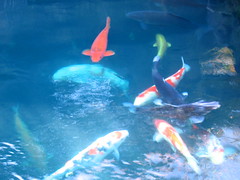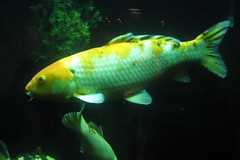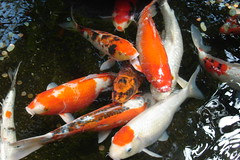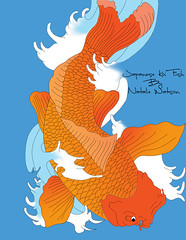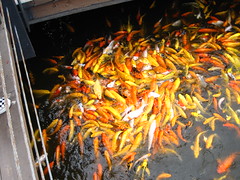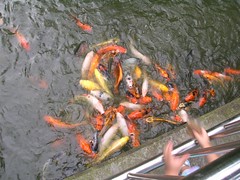In the beginning there was the ancient Carp, the Magoi, dark and uninteresting, a vital link of the food chain in China, however destined to be the forerunner of the magnificent "Living Jewels" we enjoy nowadays.
Fast forward to the early 20th century, where the color potential of these fish was discovered by the Japanese, more by accident than by design, and manipulated into the exquisite specimens nowadays recognized as Nishikigoi - literally meaning "Brocaded Koi".
Bred for their artistic splendor, modern day Koi come in a multitude of colors, patterns and varying degrees of brilliance, making them breathtaking additions to the home garden fishpond. Well treasured for their ability to instill calm and inspire a sense of inner peace, Koi are also much loved for their plentiful and diverse personalities. Not being particularly shy, they are normally very happy to be hand fed and will readily rise to the surface to greet you once they settle in.
The always increasing range of Koi colors was once restricted to Red, Black, White, Orange and Yellow, but now includes shades of Indigo, Blue, Grey, Green and Cream.
For a beginner to entirely appreciate Koi, one must begin with a basic awareness of the Japanese nomenclature for describing the traits of color, markings, shape, scalation and brilliance.
This can be a bit over-whelming to start with but it's not long before the method behind the naming becomes easily comprehensible.
Starting with colors, it's always important to note that there are often two or more Japanese words for the same color, simply because one relates to a base skin color and the other to the colored markings on top. For instance, the Japanese word for "Red" can be "Hi" indicating the red markings on top of a different color, or it can be "Aka" meaning the continuous red base skin color. The classification name results from the combination of theappropriate descriptors.
Vocabulary of Japanese Identification Words:
.
Ai - Blue or Indigo color
Aigoromo - Blue or indigo colored Goromo Koi
Ai Showa - Blue or indigo colored Showa Koi
Aka - Red - pertaining only to the base color of the fish
Asagi - Blue pertaining to koi with a bluish body and red markings on the underside, pectoral fins and cheeks
Bekko - Solid base color of red (aka), yellow (ki) or white(shiro) with black markings (sumi)
Beni - Dark red color
Budo - Grape color
Cha - Brown color
Chagoi - Brown variety of Koi noted for its splendid growth
Doitsu - German carp - either scale-less referred to as Leather Carp; or having a line of large scales along the lateral and dorsal lines referred to as Mirror Carp
Fukurin - Area around the scales of a metallic koi that displays more luster than the other areas
Gin - Silver (white metallic)
GinRin - Pearl-silver reflective scales
Goke - A fish scale
Gosanke - Group of three major varieties of koi - Kohaku, Sanke, and Showa
Goshiki - Japanese meaning "five colors." Refers to a koi with a white base color, a black and blue appearance, overlaid with red markings
Gotensakura - Kohaku variety of koi with an abundance of red spots
Hageshiro - Mostly all-black with head and snout patched with white or brown
Hagoroma - Particular variety of Aigorormo
Hajiro - Mostly all-black with tail and fins edged in white
Hariwake - White, metallic koi with gold or yellow markings
Hi - Red - pertaining only to the colored patches of the fish
Hikari - Shiny or metallic
Hikari Moyo - Metallic with platinum and either red or yellow
Hikari Utsuri - Tri-colored metallic koi with black markings - metallic versions of Showa andUtsuri
Hikari Muji - Single colored metallic koi including Ogon and Matsuba
Inazuma - "Lightning" pattern most associated with Kohaku variety
Kabuto - Japanese meaning "helmet." Refers to Koi with head color different to body color
Karas - Japanese meaning "Crow" - old variety with black fins and jet black body
Kawarimono - Term applied to Koi that cannot be classified into standard types
Ki - Yellow - relating only to the base color of the fish
Kin - Gold (yellow metallic)
Kin Rin - Pearl-gold reflective scales
Kiwa - Edge of a patch or marking
Kuchibeni - Lipstick
Matsuba - Term for scales with a pine cone or net pattern
Midori - Green color
Mono - Type
Moyo - Type of pattern
Muji - Single color
Nezu - Gray color
Orenji - Orange color
Rin - Shiny Scale
Shiro - White - relating only to the base color of the fish
Sumi - Black - pertaining only to the colored patches of the fish
Tancho - Single strong red spot on the head only
Yamabuki - Pale yellow form of the Ogon metallic koi
Interesting Facts About Koi Colors
With "Color" being high on the list of favorite attributes, it is important to examine the quality of a Koi's color when making a selection. Not only is the vibrancy of color an aesthetic choice, more importantly it's an indicator of the Koi's state of health. I the red or orange is anything but brilliant, if the black is dull, or if the white is not "snow" white, then this possibly will indicate poor health. This can be a result of poor diet or poor water quality.
Some varieties of Koi in fact change color as a consequence of temperature changes instead of poor health. Matsukawabake is one such breed.
Koi Color can in fact be improved via dietary supplements. Foods withhigh concentrations of carotenoid pigments are very beneficial and food supplements such as Spirulina (a green algae), Shrimp, plankton, daphnia and marigold are ideal. Carotene affects the red pigmentation, but if used in excess, can ruin the Koi's colors.
From time to time a Koi's colors may be less than splendid purely because it hasn't yet reached its full potential. Young koi will frequently look a little dull throughout their early development as the initial focus is on the perfection of the body shape and form instead of the improvement of color. At a specific point in their maturity, the colors will start to develop more vibrancy.
Koi colors can also be enhanced by providing good quality living conditions. Waters abundant in green phytoplankton can help develop strong yellow and red colors. Black coloring may be enriched in hard water with a pH level of 7.5-8.5. Take care however - changing the pH and hardness of the water can produce toxic levels of ammonia and nitrite.
